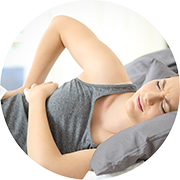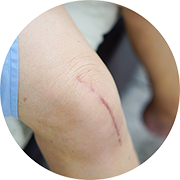

KNOW YOUR PAIN

CHRONIC LOW BACK PAIN
WHAT IS CHRONIC LOW BACK PAIN?
Low back pain is a very common condition that many people experience at some point in their lives.1 Low back pain can be a symptom of many different underlying conditions, diseases or injuries; for example, a muscle sprain in the lower back is usually followed by a sudden jolt of pain.2 However, many people with low back pain are affected by non-specific low back pain, where no specific problem or disease can be identified as to the cause of the pain.2
Low back pain can reoccur regularly and can last for several months or even years.3 Low back pain that is persistent or long term, for more than 3 months, is known as chronic low back pain.
WHAT CAUSES CHRONIC LOW BACK PAIN?
Chronic low back pain can originate from various structures in the back and can be traced in some cases to a specific bodily structure, such as muscles, joints, bones or discs. However, in many cases, the precise cause of chronic low back pain remains elusive (a mystery), and is known as ‘non-specific chronic low back pain’.4
Where the pain originates may not necessarily explain the degree of pain, as it can differ from person to person. The pain may be mild or it can be so severe that the affected person is unable to move. The intensity and frequency of low back pain is very often influenced by psychological components such as stress, depression and anxiety.2
Chronic low back pain can involve different types of pain; it often involves nociceptive pain (the body's reaction to damage/an injury) and neuropathic (nerve) pain.5
WHAT ARE TYPICAL SYMPTOMS OF CHRONIC LOW BACK PAIN?
In a study of over 32,000 people with chronic low back pain, commonly reported symptoms were:6
- Pain ‘attacks’
- Pain from applying pressure
- Burning sensation
- Prickling sensation
HOW IS CHRONIC LOW BACK PAIN DIAGNOSED?
A correct and early diagnosis is crucial to find the right treatment and relieve chronic pain symptoms. It is therefore important that symptoms are described in as much detail as possible to healthcare professionals to facilitate identification of the type of pain a person is experiencing.7
A thorough assessment of a person’s health, including medical history, a physical examination and emotional/psychological status, is essential to accurately evaluate pain.8 (Note that imaging, such as magnetic resonance imaging [MRI], may not be routinely offered by your doctor, as it does not improve a person’s ability to function in the long-term).2
Despite the various tests and examinations carried out, it can be difficult to ascertain the exact cause of chronic low back pain.
WHAT CAN YOU DO?
It is important to see a healthcare professional for advice regarding any pain condition. If you think that you might have chronic low back pain, please fill out the My Pain Questionnaire and speak to a doctor.
In addition, the Pain Diary can be used to help document and keep track of a person’s pain condition; how they feel each day, whether they are coping, their current level of pain and any side effects of treatment(s) prescribed/recommended.
It is also important to be realistic about the expectations of any treatment. Although most would like to completely eliminate their pain, reducing pain to a level that is manageable to enable a person to (re-)start activities that will lead a fulfilling life is perhaps a more achievable goal for many patients.
Chronic pain can be difficult to understand and manage on an everyday basis. The CHANGE PAIN Pain Toolkit provides handy tips and skills about self-management.
Other kinds of pain
-
References
1. Hoy D et al. Arthritis Rheum. 2012;64:2028–37.
2. Hartvigsen J et al. Lancet 2018;391:2356–67.
3. Treede RD, Rief W, Barke A, et al. Chronic pain as a symptom or a disease: The IASP Classification of Chronic Pain for the International Classification of Diseases (ICD-11). Pain 2019; 160: 19–27.
4. National Institute of Neurological Disorders and Stroke. Low back pain fact sheet. 2020. Available at: https://www.ninds.nih.gov/sites/default/files/low_back_pain_20-ns-5161_march_2020_508c.pdf. Accessed June 2021.
5. Mick G et al. Pain Manag 2012;2:71–7.
6. Hüllemann P et al. Pain Pract. 2018;18:1011–23.
7. Morlion B et al. Curr Med Res Opin 2018;34:1169–78.
8. Kress HG, Aldington D, Alon E, et al. Curr Med Res Opin 2015;31:1743–54.



